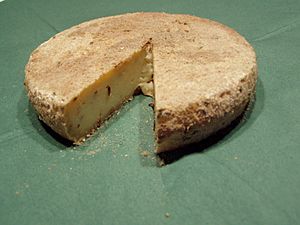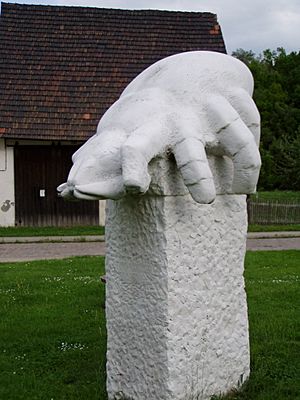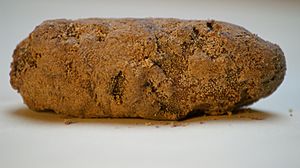Milbenkäse facts for kids
Milbenkäse (pronounced "MIL-ben-kay-zuh") is a very special German cheese. Its name means "mite cheese" because tiny cheese mites help make it! People sometimes mistakenly call it "spider cheese," but it's really made with mites.
This unique cheese starts as small balls of quark (a soft, fresh cheese). It's mixed with caraway seeds and salt. Then, these cheese balls are dried. After that, they are put into a wooden box filled with rye flour and thousands of tiny cheese mites. The mites live on the cheese for about three months.
A special liquid from the mites' bodies helps the cheese ripen and get its flavor. Milbenkäse is said to taste a bit like another German cheese called Harzer. It has a slightly bitter taste, which gets stronger as it ages. It also has a unique, zesty aftertaste. Don't worry, the mites on the outside of the cheese are eaten right along with it!
For a long time, Milbenkäse was made in parts of Germany near the towns of Zeitz and Altenburg. Today, you can only find it being made in one small village called Würchwitz in Saxony-Anhalt, Germany.
A Cheese Saved from History
The way to make Milbenkäse is very old, going all the way back to the Middle Ages. But by the 1970s, almost no one knew how to make it anymore. Only an elderly woman named Liesbeth Brauer remembered the secret method.
Luckily, a local science teacher named Helmut Pöschel learned the traditional way from her. He worked with his friend, Christian Schmelzer, to bring this special cheese back to life. Thanks to them, Milbenkäse is still made today! To celebrate saving this unique tradition, a special monument to the cheese mite was built in Würchwitz.
How Milbenkäse is Made
Making Milbenkäse is a fascinating process. First, quark cheese is mixed with salt and caraway seeds. This mixture is then shaped into small balls, cylinders, or wheels. These shapes are left to dry.
Next, the dried cheese is placed into a wooden box. This box is special because it's home to many tiny Tyrophagus casei mites. The cheese stays with the mites for at least three months. The rye flour in the box is important because it helps keep the mites busy. If there was no flour, the mites might eat the whole cheese instead of just nibbling at the outside!
The mites' special digestive juices spread into the cheese. These juices cause the cheese to change and ripen. After about one month, the outside of the cheese turns yellow. After three months, it becomes a reddish-brown color. Some cheesemakers let the cheese ripen for up to a year. When it's that old, it turns completely black!
Other Cheeses with Mites
Did you know that cheese mites are used in other places to help ripen cheese? One famous example is a French cheese called Mimolette. It comes from northeastern France and Belgium.
Other French cheeses, especially from the mountains, sometimes have cheese mites on their crust by accident. These include older types of Cantal and Salers. Most of these cheeses are harder cheeses, while Milbenkäse is a softer, sour milk cheese.
There's also a Spanish cheese called Cabrales cheese. It comes from the Asturias region. This cheese also has living cheese mites, but not as many. They live in the moldy parts of the cheese and don't play a big role in ripening it.
Another very unique cheese that contains living creatures is casu marzu from Sardinia. This cheese has maggots (larvae) from the cheese fly living inside it!
See also
 In Spanish: Milbenkäse para niños
In Spanish: Milbenkäse para niños




